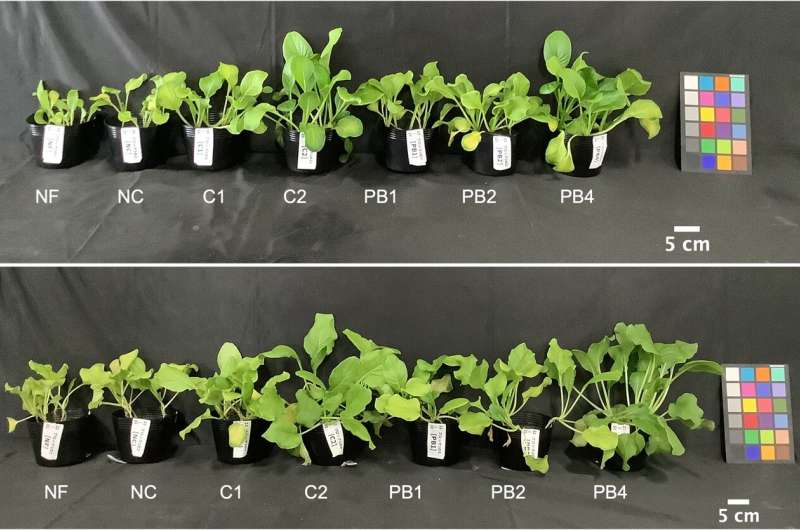This article has been reviewed according to Science X's editorial process and policies. Editors have highlighted the following attributes while ensuring the content's credibility:
fact-checked
trusted source
proofread
Mashed up purple marine bacteria makes an excellent eco-friendly fertilizer

New research published in npj Sustainable Agriculture reports that biomass made from the purple photosynthetic marine bacterium Rhodovulum sulfidophilum is an excellent nitrogen fertilizer.
Led by Keiji Numata from the RIKEN Center for Sustainable Resource Science (CSRS) and Kyoto University, the study shows that this biomass is as effective as common inorganic synthetic fertilizers but avoids several side effects that harm the environment.
Increasing agricultural output using nitrogen-rich fertilizers is a common practice that is expected to increase in the coming decades as global food demands rise. As this happens, the ecologically harmful side effects of overusing common inorganic nitrogen fertilizers are also expected to skyrocket, including substantial greenhouse gas emissions, contaminated ground water, and poor soil quality.
On the other hand, organic fertilizers such as compost and manure have much less nitrogen, and must therefore be used in greater amounts for the same effect on plant growth. This leads to excessively salty soil, which is toxic and stunts plant growth, as well as more carbon dioxide and nitrous oxide byproducts in the long run.
The Biomacromolecules Research Team at RIKEN CSRS has been searching for a natural source of nitrogen that can replace ammonia-based synthetic fertilizers and help prevent a future crisis. Purple non-sulfur bacteria (PNSBs) are known to have enzymes that help them take nitrogen from the atmosphere and incorporate it into proteins, but until now, no one has tested their effectiveness as fertilizers.
To create a PNSB fertilizer for the new study, the team mashed up the PNSB R. sulfidophilum and generated dried biomass from the released cellular material. Analysis showed that the nitrogen content of the PNSB fertilizer was 11% by weight, which is much higher than what is found in other organic fertilizers, including biomass made from other microbes or microalgae.
The researchers compared how well the Japanese mustard spinach komatsuna (Brassica rapa var. perviridis) grew when assisted by either inorganic fertilizers or the new PNSB biomass fertilizer. The first major finding was that the mustard spinach could indeed absorb nitrogen from the dried biomass.
Further experiments showed that the biomass fertilizer boosted plant growth just as well as the nitrogen-rich inorganic fertilizers did, at both cool and warm temperatures. On top of that, even when the biomass fertilizer contained up to four times the amount of nitrogen, soil pH and salinity remained normal, similar to soil fertilized without any nitrogen.
The PNSB biomass fertilizer has a low carbon to nitrogen ratio and the nitrogen is released for plant use relatively slowly compared with inorganic fertilizers—about 60% in 30 days. Although this means that twice as much biomass fertilizer will be needed for similar crop growth, the big upside is that carbon dioxide and nitrous oxide emissions will be lower, and less nitrogen will be dumped into the environment through leaching.
"In the long term this could revolutionize agriculture and mitigate its negative impact on the environment," says Morey-Yagi, one of the study's lead authors.
Although the basic experiments prove the effectiveness of the biomass fertilizer, the authors stress that results are preliminary and other factors will eventually need to be taken into consideration.
As Numata explains, "A life-cycle assessment of this fertilizer will be essential for evaluating its environmental footprint across production, storage, application, transport, and disposal."
Additionally, how to scale-up the biomass production process must be considered, and shelf-life must also be established.
The researchers are optimistic that these challenges will be met and that their discovery will help make fertilizers more eco-friendly and help prevent future problems with supply-chain distribution of inorganic fertilizers.
Because the biomass fertilizer is produced using carbon dioxide and nitrogen from the air, they have named it Air Fertilizer and have registered it for use as an organic fertilizer in Japan as a product marketed by Symbiobe Inc.
More information: Shamitha Rao Morey-Yagi et al, Utilization of lysed and dried bacterial biomass from the marine purple photosynthetic bacterium Rhodovulum sulfidophilum as a sustainable nitrogen fertilizer for plant production, npj Sustainable Agriculture (2024). DOI: 10.1038/s44264-024-00018-0
Provided by RIKEN




















